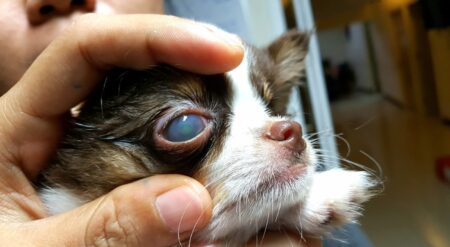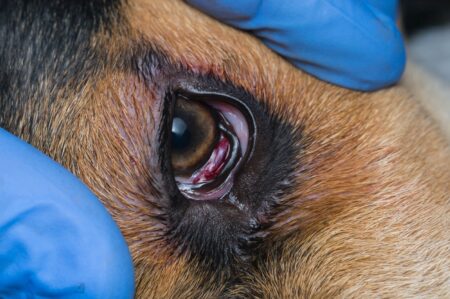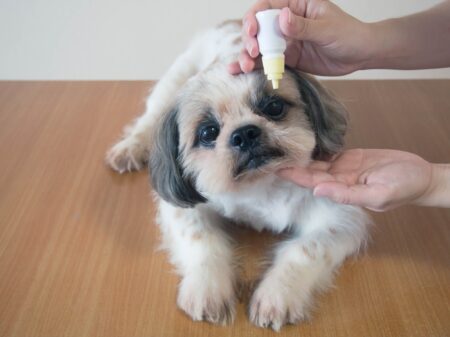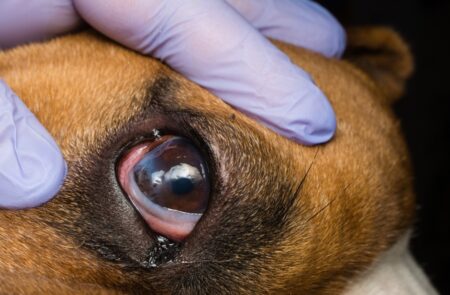Dog Eye Ulcer: Causes And Treatment
Dog eye ulcers can be a serious condition that can cause a lot of discomfort and anxiety for both pet parents and their furry family members. Dog eye ulcer is an inflammation of the cornea due to a sudden trauma or infection. Several underlying causes can lead to the formation of an eye ulcer, such as bacteria, fungi, parasites, foreign bodies, and even allergies. Although there are different treatment options available, depending on the cause of the ulcer, your veterinarian will typically recommend treatment that may include antibiotics, antifungals, and/or other topical/oral medications. It is important that dog owners recognize the signs of an eye ulcer and seek immediate veterinary care for their pets.
Dog Eye Ulcer: Causes And Treatment
Dog eye ulcers are open superficial wounds of the cornea caused by injury, infection, or inflammation. Common causes of this condition include trauma, eye irritation, corneal dystrophy, and infection. Symptoms include excessive blinking, tearing, increased redness, discharge, and light sensitivity. Your veterinarian may perform a complete physical exam and ophthalmic exam as well as laboratory tests to determine the cause of the ulcer. Treatment for eye ulcers may involve topical antibiotics, anti-inflammatories, and lubricants to reduce the healing time. In more severe cases, surgery may be necessary to repair the cornea.
What is Eye Ulcer in Dogs?
An eye ulcer in dogs is an open sore on the surface of the eye. It is caused by trauma to the eye, infection, or inflammation. It can be extremely painful for the dog and can lead to corneal damage. Symptoms of an eye ulcer include squinting, discharge from the eye, and redness around the eye. Treatment for an eye ulcer in dogs typically involves antibiotics and topical medications. In more severe cases, surgery may be necessary.
Dog Eye Ulcer Won’t Heal
Dog eye ulcers won’t heal because eye ulcers are typically caused by the surface of the eye being damaged, such as by a scratch from a nail or other object, or due to an underlying eye infection or disease that is causing irritation or inflammation. In either case, the healing process can be slow or inhibited due to the delicate nature of the area, the difficulty of keeping the eye patched or shielded from further irritation, the lack of appropriate medications to speed up the healing process, or difficulty delivering those medications to the eye (through eye drops or ointments). Also, underlying conditions that may be causing the ulcer may be contributing to the difficulty in healing.
Dog Eye Ulcer Surgery Cost
Dog eye ulcer surgery is a procedure performed to treat ulcers that form in the eye. It is a highly specialized type of surgery that requires a high level of medical skill and precision, making it one of the more expensive types of surgery for dogs.
The cost of dog eye ulcer surgery will vary depending on the type of surgery needed, as well as the severity of the ulcer. Generally, mild cases of ulcers will require scraping the affected area of the eye and flushing with medication, while more severe cases may require a flap to be created or an incision to be made. To determine the exact cost, it’s best to consult with your veterinarian. Generally, costs range from hundreds to thousands of dollars, depending on the circumstances.
SEE ALSO: Dog-Friendly Beaches in Florida: Best Picks
Causes of Eye Ulcers in Dogs
- Bacterial infections: Bacterial infections are a common cause of eye ulcers in dogs. The most common bacterial agents for causing eye ulcers are Staphylococcus aureus and Streptococcus, both of which can be caused by bacteria that are already present in the dog’s environment. These bacteria can penetrate the surface of the eye and create a corneal ulcer.
- Allergies: Allergies to grass, dust, or other environmental allergens can lead to eye ulcers. These allergies can cause the dog’s eye to become dry and irritated, leading to a breakdown of the surface of the eye and ulcer formation.
- Injury: Traumatic injury to the eye, such as a scratch or puncture wound, can also lead to the formation of an eye ulcer.
- Foreign bodies: Objects such as dirt, sand, or plant material that get lodged in the eye can cause irritation and lead to ulceration of the corneal surface.
- Autoimmune disorders: Dogs with autoimmune diseases can develop a condition called keratitis sicca, which can lead to corneal ulceration.
- Eye diseases: Certain eye diseases can lead to ulceration of the corneal surface, including pannus and focal corneal sequestrum.
- Cancer: Dogs that develop malignant tumors of the eye can sometimes develop ulceration of the eye surface.
Dog Eye Ulcer Symptoms
Signs of a dog eye ulcer include squinting, reddening of the white of the eye (called chemosis), eye discharge, bulging of the eye, pawing at the eye, and visible clouding or opacity in the eye. Your dog may also be sensitive to light. If your dog is showing any of these symptoms, it is crucial to take them to the vet for a comprehensive eye exam.
Dog Breeds at High-risk Eye Ulcer
Certain breeds of dogs are more prone to eye ulcers than others. These breeds include:
- Cocker Spaniels
- Weimaraners
- Boxers
- Bullmastiffs
- Labrador Retrievers
- Bloodhounds
- Boston Terriers
- Poodles
- Bull Terriers
- Rough Collies
Diagnosing Eye Ulcers in Dogs
At home, you can assess your pet for common signs and symptoms of eye ulcers, including ocular discharge (watery, mucous, or pus-like), inflammation, redness, irritation of the eye, squinting or blinking of the eye, or excessive tearing.
At the veterinarian, the eye will be examined with a slit lamp or fluorescent dye, which will allow the veterinarian to see if there are any visible ulcerations on the eyeball. The veterinarian will also swab the eye for a culture to identify the type of bacteria or virus, causing the ulcer so that appropriate treatment can be administered. In some cases, the veterinarian may also take blood samples to determine if there are underlying medical conditions that could be causing the eye ulcer.
Treatment of Eye Ulcers in Dogs
Eye ulcers in dogs are serious conditions that need to be treated right away. There are several treatments available depending on the cause and severity of the ulcer. Treatment typically involves antibiotics, topical ointments, and frequent monitoring. Surgery may be needed in severe cases.
- Antibiotics: If the ulcer is caused by an infection, your veterinarian may prescribe antibiotics to help treat it. Oral antibiotics, eye drops, or ointments are typically used. The type of antibiotic prescribed will depend on the cause and severity of the ulcer.
- Topical medications: Topical medications may be used in conjunction with antibiotics to help speed healing and reduce inflammation. These can include corticosteroids, cyclosporine, and other topical agents.
- Surgery: In more severe cases, a veterinarian may recommend surgery. Surgery may be necessary to excise a damaged cornea or to remove foreign material.
- Frequent monitoring: Your veterinarian may advise frequent monitoring to make sure the ulcer is healing properly. They may take tests such as blood work and a slit lamp exam to check that the ulcer is progressing well.
If you think your dog has an eye ulcer, take them to the veterinarian as soon as possible. If left untreated, the condition can lead to vision loss or even permanent blindness.
Dog Eye Ulcer Home Remedy
- Clean the area with a hypochlorite solution (available at most pharmacies).
- Provide nutritious meals to reduce the chance of inflammation.
- Give your pet omega-3 fatty acids to reduce inflammation.
- Apply a cooled sterile saline solution to the area several times a day to help with healing.
Signs a Dog Eye Ulcer is Healing
- Reduction in squinting or closing the affected eye.
- Increases in activity level.
- Reduction in redness and swelling of the affected eye.
- Return of normal pupillary reflex.
- Appearing more alert and comfortable.
- Reduced sensitivity to light.
- Improvement in vision.
How to Prevent Dog Eye Ulcers
- Monitor your dog’s eye health. Checking your dog for signs of eye irritation, redness or discharge is the best way to catch any developing eye ulcers.
- Keep your dog’s environment clean. Making sure your home and yard are free from debris, dust, or other irritants can help keep your dog from developing eye ulcers.
- Make sure your dog is getting enough nutrients. Ensure your pet is getting all the nutrients it needs from its diet, which can help reduce the chance of developing eye ulcers.
- Protect their eyes from irritation. If you know your dog will be outside in rough or dry conditions, purchase protective eyewear for them to help prevent eye irritation and possible ulcer formation.
- Make sure your pet is getting regular check-ups. Taking your pet to the vet regularly helps to catch any underlying health problems that could lead to eye ulcers.
SEE ALSO: Dog Ear Cleaning Solution: Best Picks
FAQs
Q. Can eye ulcers in dogs be cured?
A. Yes, eye ulcers in dogs can typically be cured with treatment that typically includes antibiotics and special ointments.
Q. Can you treat a dog’s eye ulcer at home?
A. No, it is recommended to seek professional help from a veterinarian for any eye problem in a dog.
Q. Will a dog’s eye ulcer heal on its own?
A. It depends on the severity of the eye ulcer. Minor eye ulcers may heal on their own, while more severe ulcers may require medical treatment in order to heal properly.
Q. How serious is an ulcer in a dog’s eye?
A. An ulcer in a dog’s eye can be very serious, and it should be evaluated and treated by a veterinarian as soon as possible. If left untreated, ulcers can cause permanent damage to the eye and may even lead to blindness.
Conclusion
Dog eye ulcer, also known as corneal ulcers or ulcerative keratitis, is a serious condition that should be treated immediately. If left untreated, it can lead to blindness or even cause painful itchy eyes. Causes of dog eye ulcers may include trauma, infection, and foreign bodies and can be treated successfully with prompt medical intervention. However, prevention is always better than cure when dealing with any type of eye issue, and keeping your dog away from any injury or foreign debris can go a long way in avoiding such eye problems.


